World Roundup
November/December 2016


-
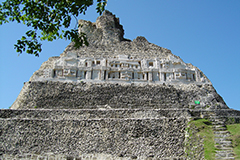 BELIZE: The occupant of one of the largest Maya tombs discovered in the country—in one of the few known Maya funerary pyramids—wasn’t the most surprising find in a recent exploration of a massive temple at the site of Xunantunich. Also found there were two hieroglyphic panels believed to have come from a dismantled ceremonial stairway at the city of Caracol. Almost all the panels—which tell the story of a victory of Caracol over the city of Naranjo—had previously been found, except for these two, from the tale’s beginning and end. —Samir S. Patel
BELIZE: The occupant of one of the largest Maya tombs discovered in the country—in one of the few known Maya funerary pyramids—wasn’t the most surprising find in a recent exploration of a massive temple at the site of Xunantunich. Also found there were two hieroglyphic panels believed to have come from a dismantled ceremonial stairway at the city of Caracol. Almost all the panels—which tell the story of a victory of Caracol over the city of Naranjo—had previously been found, except for these two, from the tale’s beginning and end. —Samir S. Patel -
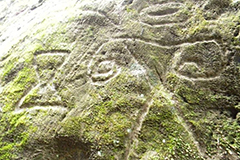 MONTSERRAT: Hikers in the dense forest of this British Overseas Territory—an island that has been devastated by volcanic eruptions over the last 20 years—found its first known petroglyphs, a series of designs both geometric and apparently figurative, carved into a mossy boulder. They appear to date to more than 1,000 years ago, and were left by the Arawak people, who had settled much of the Caribbean prior to the arrival of Europeans. —Samir S. Patel
MONTSERRAT: Hikers in the dense forest of this British Overseas Territory—an island that has been devastated by volcanic eruptions over the last 20 years—found its first known petroglyphs, a series of designs both geometric and apparently figurative, carved into a mossy boulder. They appear to date to more than 1,000 years ago, and were left by the Arawak people, who had settled much of the Caribbean prior to the arrival of Europeans. —Samir S. Patel -
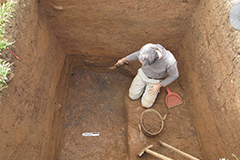 BRAZIL: The proto-Jê cultures in the southern highlands made ceremonial mounds and enclosures, as well as pit houses that were used for decades, even centuries. It had originally been assumed that these large dwellings were occupied, then abandoned, then occupied again, but recent research shows that they were inhabited continuously over long periods of time, with family groups remodeling them over the years. The house that archaeologists dated in detail was in use from the end of the 14th century to the beginning of the 17th. —Samir S. Patel
BRAZIL: The proto-Jê cultures in the southern highlands made ceremonial mounds and enclosures, as well as pit houses that were used for decades, even centuries. It had originally been assumed that these large dwellings were occupied, then abandoned, then occupied again, but recent research shows that they were inhabited continuously over long periods of time, with family groups remodeling them over the years. The house that archaeologists dated in detail was in use from the end of the 14th century to the beginning of the 17th. —Samir S. Patel -
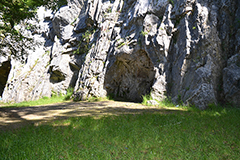 BELGIUM: A set of human and animal bones from Goyet Cave, first excavated 150 years ago, have produced the first clear evidence of Neanderthal cannibalism north of the Alps. Bone fragments recently identified as Neanderthal show signs of cut marks and percussion breaking, and four of them hold evidence of having been used as implements for crafting and retouching stone tools. The bones date to around 40,000 to 45,000 years ago, not long before the human subspecies went extinct. Other Neanderthal groups in the region appear to have buried their dead. —Samir S. Patel
BELGIUM: A set of human and animal bones from Goyet Cave, first excavated 150 years ago, have produced the first clear evidence of Neanderthal cannibalism north of the Alps. Bone fragments recently identified as Neanderthal show signs of cut marks and percussion breaking, and four of them hold evidence of having been used as implements for crafting and retouching stone tools. The bones date to around 40,000 to 45,000 years ago, not long before the human subspecies went extinct. Other Neanderthal groups in the region appear to have buried their dead. —Samir S. Patel -
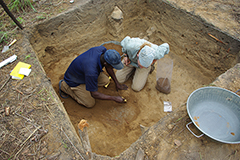 GHANA: In many parts of the world, ages ago as today, if the rains fail, people go hungry or have to turn to less nourishing alternative food sources. But researchers examining plant remains and other artifacts in the rural Banda district have found that 500 years ago, people there did not experience such “food stress,” but were able to continue eating their preferred pearl millet—in wet times and dry. Food security and storage, they theorize, was stronger prior to British colonial presence because economies were more diverse and people weren’t encouraged to sell their harvests for cash. —Samir S. Patel
GHANA: In many parts of the world, ages ago as today, if the rains fail, people go hungry or have to turn to less nourishing alternative food sources. But researchers examining plant remains and other artifacts in the rural Banda district have found that 500 years ago, people there did not experience such “food stress,” but were able to continue eating their preferred pearl millet—in wet times and dry. Food security and storage, they theorize, was stronger prior to British colonial presence because economies were more diverse and people weren’t encouraged to sell their harvests for cash. —Samir S. Patel -
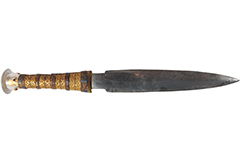 EGYPT: Among the many items buried with Tutankhamun in Egypt’s Valley of the Kings is an iron dagger. This was centuries before iron smelting emerged in the region, so there has long been academic discussion about whether the iron for the blade was smelted elsewhere and imported as a gift, or came from a metallic meteorite. Using portable X-ray fluorescence spectrometry, physicists have determined, based on the blade’s composition, that it was likely made from meteoritic iron, which the Egyptians called bia-n-pt or, literally, “iron from the sky.” —Samir S. Patel
EGYPT: Among the many items buried with Tutankhamun in Egypt’s Valley of the Kings is an iron dagger. This was centuries before iron smelting emerged in the region, so there has long been academic discussion about whether the iron for the blade was smelted elsewhere and imported as a gift, or came from a metallic meteorite. Using portable X-ray fluorescence spectrometry, physicists have determined, based on the blade’s composition, that it was likely made from meteoritic iron, which the Egyptians called bia-n-pt or, literally, “iron from the sky.” —Samir S. Patel -
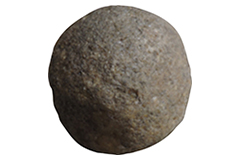 SOUTH AFRICA: No animal besides humans can throw a five-ounce spheroid object more than 105 miles an hour (see Aroldis Chapman, Chicago Cubs pitcher). Recent experiments indicate that our facility with throwing may have been an evolutionary advantage. According to simulations, spheroids, or ball-shaped stones, found at African archaeological sites as old as 1.8 million years, appear to have been the ideal weight and size to inflict worthwhile damage to medium-sized prey animals at distances up to 80 feet. For the record, batters stand 60 feet, 6 inches, from Chapman. Be careful not to crowd the plate. —Samir S. Patel
SOUTH AFRICA: No animal besides humans can throw a five-ounce spheroid object more than 105 miles an hour (see Aroldis Chapman, Chicago Cubs pitcher). Recent experiments indicate that our facility with throwing may have been an evolutionary advantage. According to simulations, spheroids, or ball-shaped stones, found at African archaeological sites as old as 1.8 million years, appear to have been the ideal weight and size to inflict worthwhile damage to medium-sized prey animals at distances up to 80 feet. For the record, batters stand 60 feet, 6 inches, from Chapman. Be careful not to crowd the plate. —Samir S. Patel -
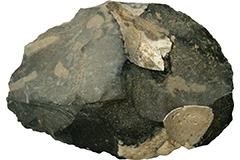 JORDAN: Stone tools dating back a quarter of a million years have yielded the oldest known protein food residues ever observed and are providing insight into the diet of ancient hominins who would have been living in an increasingly arid and marginal environment. On the menu were rhinoceros, wild cattle, horses, and ducks. This surprising diversity—and the range of hunting techniques it would have required—suggests, according to the researchers, an adaptability that would have served Middle Pleistocene hominins well as they dispersed across Eurasia’s highly variable landscapes. —Samir S. Patel
JORDAN: Stone tools dating back a quarter of a million years have yielded the oldest known protein food residues ever observed and are providing insight into the diet of ancient hominins who would have been living in an increasingly arid and marginal environment. On the menu were rhinoceros, wild cattle, horses, and ducks. This surprising diversity—and the range of hunting techniques it would have required—suggests, according to the researchers, an adaptability that would have served Middle Pleistocene hominins well as they dispersed across Eurasia’s highly variable landscapes. —Samir S. Patel -
 HONG KONG: The waters of this Chinese territory could be one of the most extensive and largely untapped resources for maritime heritage anywhere in the world. Everything from Neolithic artifacts to Arab, Indian, and Persian trading ships to Chinese and European colonial vessels could lie in its waters, but to date little underwater archaeology has been conducted there. The recent discoveries of a 1,000-year-old granite anchor stock (the oldest maritime artifact found in Chinese waters) and a 19th-century European cannon hint at what might lie below. —Samir S. Patel
HONG KONG: The waters of this Chinese territory could be one of the most extensive and largely untapped resources for maritime heritage anywhere in the world. Everything from Neolithic artifacts to Arab, Indian, and Persian trading ships to Chinese and European colonial vessels could lie in its waters, but to date little underwater archaeology has been conducted there. The recent discoveries of a 1,000-year-old granite anchor stock (the oldest maritime artifact found in Chinese waters) and a 19th-century European cannon hint at what might lie below. —Samir S. Patel -
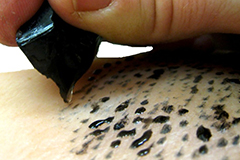 SOLOMON ISLANDS: Using obsidian and pig skin, researchers are attempting to determine whether certain artifacts found at archaeological sites in Melanesia had been used for tattooing. They conducted these experiments to observe the wear, such as chipping and scratches, and residues on the stone caused by tattooing, and then compared that use-wear with 3,000-year-old artifacts. They found that the obsidian pieces, old and new, show similar patterns, suggesting that they hadn’t been used for working hides, but were for adorning human skin. —Samir S. Patel
SOLOMON ISLANDS: Using obsidian and pig skin, researchers are attempting to determine whether certain artifacts found at archaeological sites in Melanesia had been used for tattooing. They conducted these experiments to observe the wear, such as chipping and scratches, and residues on the stone caused by tattooing, and then compared that use-wear with 3,000-year-old artifacts. They found that the obsidian pieces, old and new, show similar patterns, suggesting that they hadn’t been used for working hides, but were for adorning human skin. —Samir S. Patel
Advertisement
IN THIS ISSUE
From the Trenches
Piltdown’s Lone Forger
Off the Grid
Codex Subtext
The Rabbit Farms of Teotihuacán
Murder on the Mountain?
Breaking Cahokia’s Glass Ceiling
Evolve and Catch Fire
Coast over Corridor
Ötzi’s Sartorial Splendor
And They’re Off!
The Blood of the King
China’s Legendary Flood
Shifting Sands
Man Meets Dog, Both Meet Death
World Roundup
Maya victory monument, Neanderthal cannibals, Paleolithic smorgasbord, King Tut’s meteor dagger, and Melanesian tattooing
Artifact
A Cambridge don’s magic shoe
Advertisement

Recent Issues
-
 May/June 2024
May/June 2024
-
 March/April 2024
March/April 2024
-
 January/February 2024
January/February 2024
-
 November/December 2023
November/December 2023
-
 September/October 2023
September/October 2023
-
 July/August 2023
July/August 2023
-
 May/June 2023
May/June 2023
-
 March/April 2023
March/April 2023
-
 January/February 2023
January/February 2023
-
 November/December 2022
November/December 2022
-
 September/October 2022
September/October 2022
-
 July/August 2022
July/August 2022
-
 May/June 2022
May/June 2022
-
 March/April 2022
March/April 2022
-
 January/February 2022
January/February 2022
-
 November/December 2021
November/December 2021
-
 September/October 2021
September/October 2021
-
 July/August 2021
July/August 2021
-
 May/June 2021
May/June 2021
-
 March/April 2021
March/April 2021
-
 January/February 2021
January/February 2021
-
 November/December 2020
November/December 2020
-
 September/October 2020
September/October 2020
-
 July/August 2020
July/August 2020
-
 May/June 2020
May/June 2020
-
 March/April 2020
March/April 2020
-
 January/February 2020
January/February 2020
-
 November/December 2019
November/December 2019
-
 September/October 2019
September/October 2019
-
 July/August 2019
July/August 2019
-
 May/June 2019
May/June 2019
-
 March/April 2019
March/April 2019
-
 January/February 2019
January/February 2019
-
 November/December 2018
November/December 2018
-
 September/October 2018
September/October 2018
-
 July/August 2018
July/August 2018
-
 May/June 2018
May/June 2018
-
 March/April 2018
March/April 2018
-
 January/February 2018
January/February 2018
-
 November/December 2017
November/December 2017
-
 September/October 2017
September/October 2017
-
 July/August 2017
July/August 2017
-
 May/June 2017
May/June 2017
-
 March/April 2017
March/April 2017
-
 January/February 2017
January/February 2017
-
 November/December 2016
November/December 2016
-
 September/October 2016
September/October 2016
-
 July/August 2016
July/August 2016
-
 May/June 2016
May/June 2016
-
 March/April 2016
March/April 2016
-
 January/February 2016
January/February 2016
-
 November/December 2015
November/December 2015
-
 September/October 2015
September/October 2015
-
 July/August 2015
July/August 2015
-
 May/June 2015
May/June 2015
-
 March/April 2015
March/April 2015
-
 January/February 2015
January/February 2015
-
 November/December 2014
November/December 2014
-
 September/October 2014
September/October 2014
-
 July/August 2014
July/August 2014
-
 May/June 2014
May/June 2014
-
 March/April 2014
March/April 2014
-
 January/February 2014
January/February 2014
-
 November/December 2013
November/December 2013
-
 September/October 2013
September/October 2013
-
 July/August 2013
July/August 2013
-
 May/June 2013
May/June 2013
-
 March/April 2013
March/April 2013
-
 January/February 2013
January/February 2013
-
 November/December 2012
November/December 2012
-
 Sep/Oct 2012
Sep/Oct 2012
-
 September/October 2012
September/October 2012
-
 July/August 2012
July/August 2012
-
 May/June 2012
May/June 2012
-
 March/April 2012
March/April 2012
-
 January/February 2012
January/February 2012
-
 November/December 2011
November/December 2011
-
 September/October 2011
September/October 2011
-
 July/August 2011
July/August 2011
-
 May/June 2011
May/June 2011
-
 March/April 2011
March/April 2011
-
 January/February 2011
January/February 2011
Advertisement






